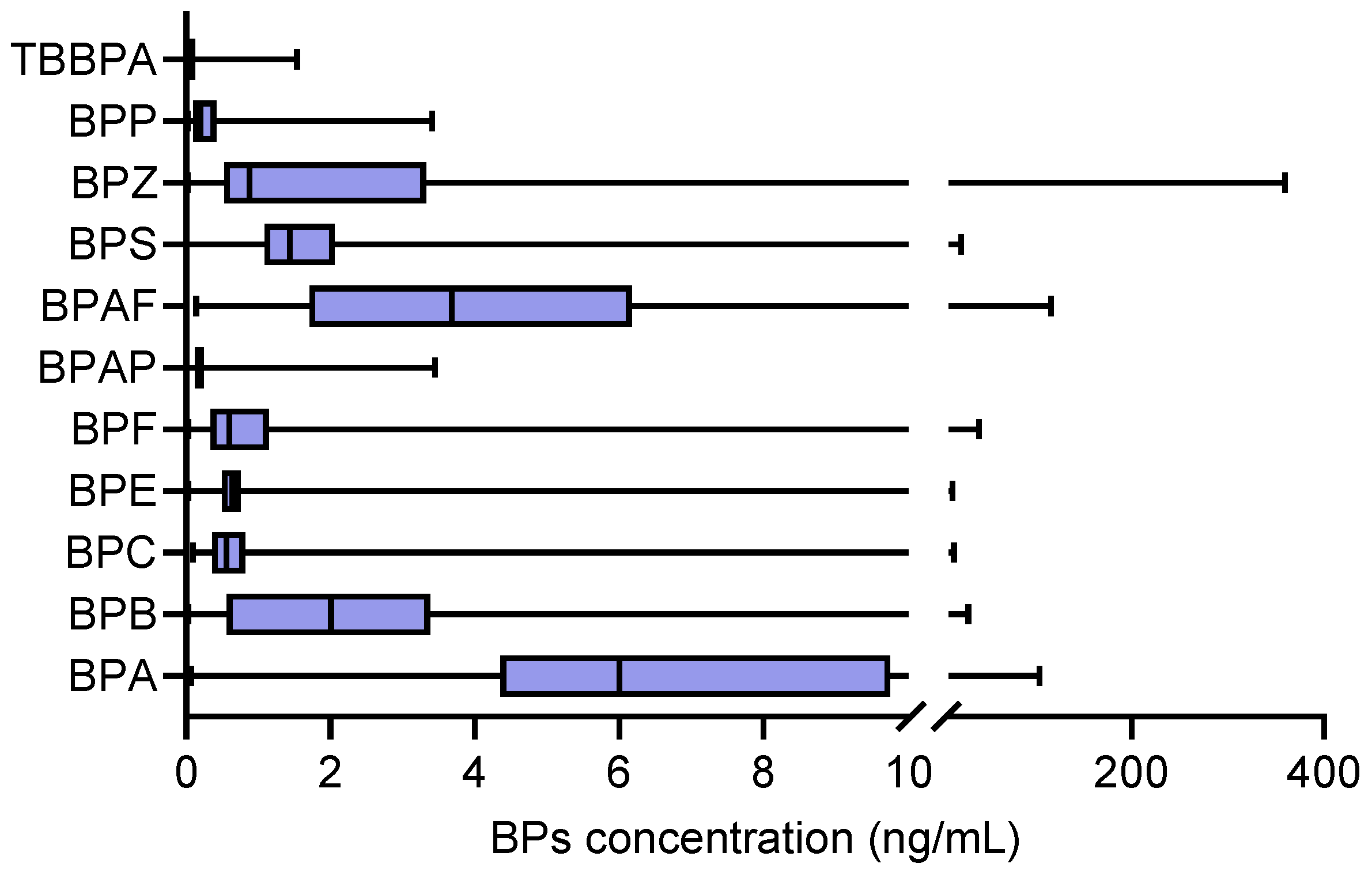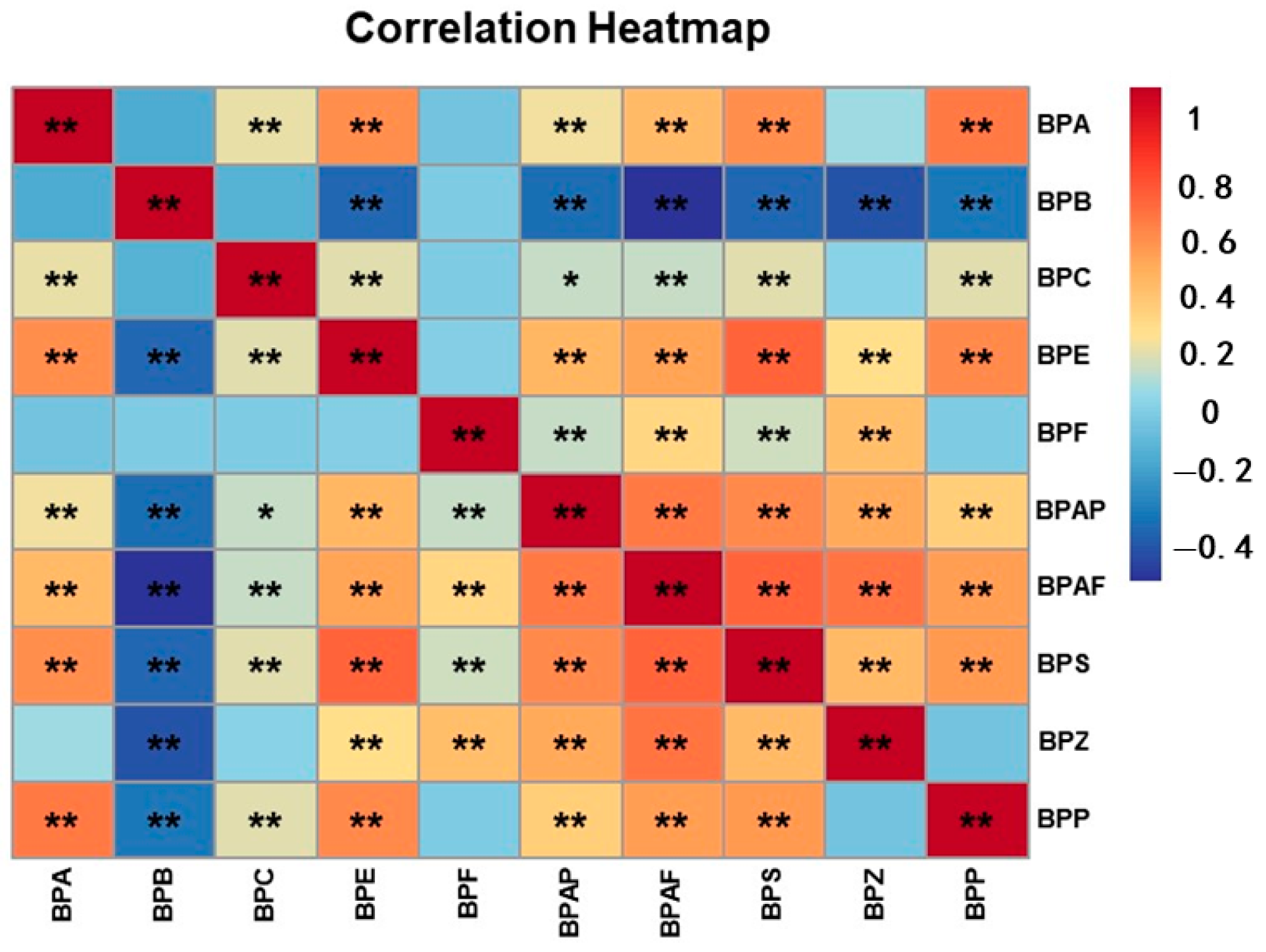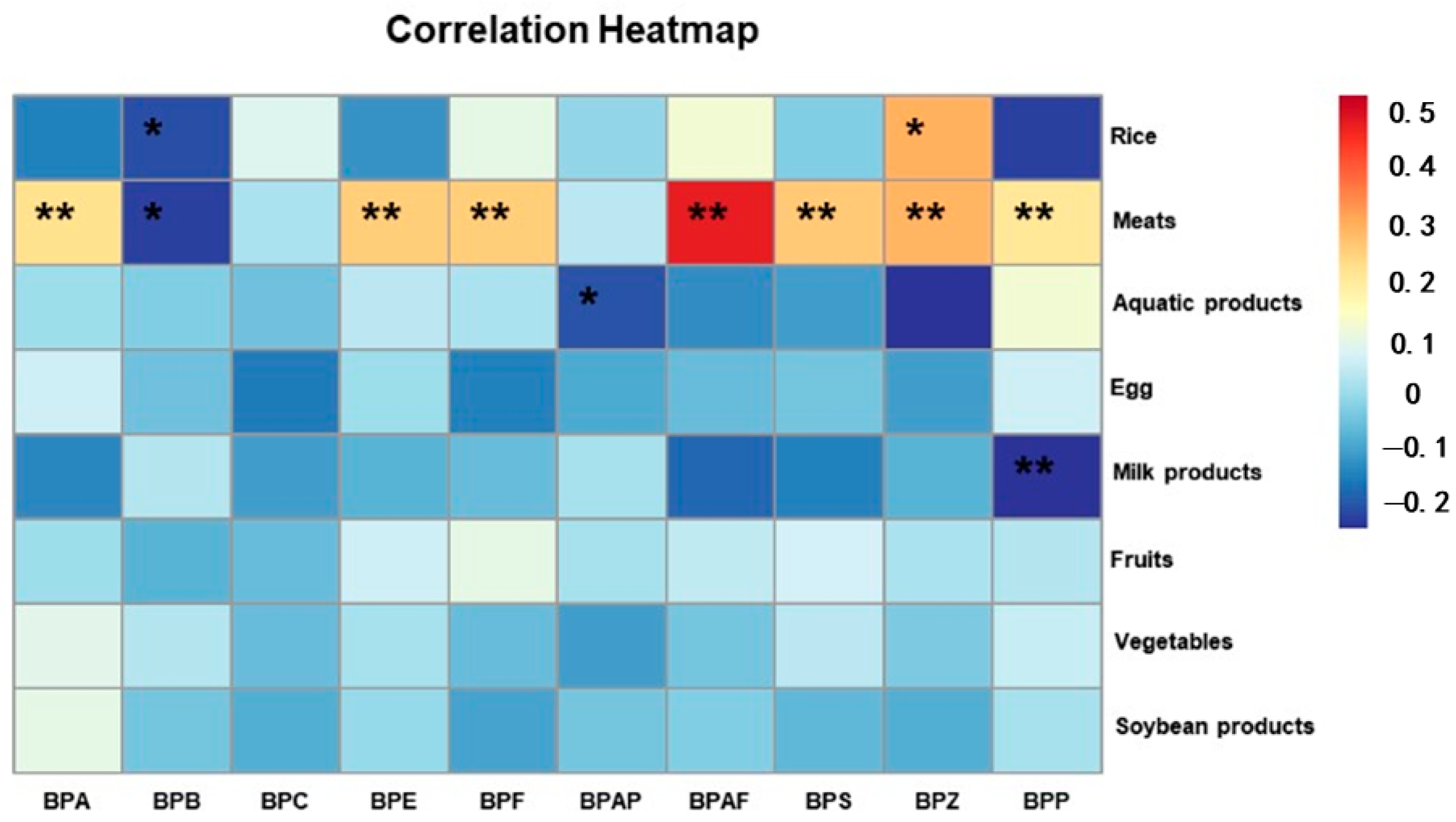Internal Bisphenol Analogue Exposure in an Elderly Chinese Population: Knowledge from Dietary Exposure
Abstract
1. Introduction
2. Materials and Methods
2.1. Chemicals and Reagents
2.2. Participant Sample Collection
2.3. Blood Sample Preparation
2.4. Instrumental Analysis
2.5. Method Validation
2.6. Statistical Analysis
3. Results
3.1. Basic Information of Survey Population
3.2. BP Internal Exposure in the Elderly
3.3. Associations Between Serum BP Levels and Gender and Age
3.4. Relationship Between Serum BP Levels and Diet
4. Discussion
5. Conclusions
Supplementary Materials
Author Contributions
Funding
Institutional Review Board Statement
Informed Consent Statement
Data Availability Statement
Acknowledgments
Conflicts of Interest
References
- Qiu, W.; Zhan, H.; Hu, J.; Zhang, T.; Xu, H.; Wong, M.; Xu, B.; Zheng, C. The occurrence, potential toxicity, and toxicity mechanism of bisphenol S, a substitute of bisphenol A: A critical review of recent progress. Ecotoxicol. Environ. Saf. 2019, 173, 192–202. [Google Scholar] [CrossRef] [PubMed]
- Dagdeviren, G.; Arslan, B.; Keles, A.; Yucel Celik, O.; Arat, O.; Caglar, A.T. The evaluation of serum bisphenol A in patients with preeclampsia. J. Obstet. Gynaecol. Res. 2023, 49, 1322–1327. [Google Scholar] [CrossRef] [PubMed]
- Gramec Skledar, D.; Peterlin Mašič, L. Bisphenol A and its analogs: Do their metabolites have endocrine activity? Environ. Toxicol. Pharmacol. 2016, 47, 182–199. [Google Scholar] [CrossRef] [PubMed]
- Pivonello, C.; Muscogiuri, G.; Nardone, A.; Garifalos, F.; Provvisiero, D.P.; Verde, N.; de Angelis, C.; Conforti, A.; Piscopo, M.; Auriemma, R.S.; et al. Bisphenol A: An emerging threat to female fertility. Reprod. Biol. Endocrinol. 2020, 18, 22. [Google Scholar] [CrossRef]
- Hong, X.; Wang, G.; Liu, X.; Wu, M.; Zhang, X.; Hua, X.; Jiang, P.; Wang, S.; Tang, S.; Shi, X.; et al. Lipidomic biomarkers: Potential mediators of associations between urinary bisphenol A exposure and colorectal cancer. J. Hazard. Mater. 2022, 427, 127863. [Google Scholar] [CrossRef]
- Nie, H.; Wang, F.; Zhang, Y.; Zhang, S.; Han, X.; Zhang, X.; Guo, H.; He, M. Associations of serum bisphenol A levels with incident chronic kidney disease risk. Sci. Total. Environ. 2021, 771, 145401. [Google Scholar] [CrossRef]
- Jurewicz, J.; Majewska, J.; Berg, A.; Owczarek, K.; Zajdel, R.; Kaleta, D.; Wasik, A.; Rachon, D. Serum bisphenol A analogues in women diagnosed with the polycystic ovary syndrome—Is there an association? Environ. Pollut. 2021, 272, 115962. [Google Scholar] [CrossRef]
- Oliviero, F.; Marmugi, A.; Viguie, C.; Gayrard, V.; Picard-Hagen, N.; Mselli-Lakhal, L. Are BPA Substitutes as Obesogenic as BPA? Int. J. Mol. Sci. 2022, 23, 4238. [Google Scholar] [CrossRef]
- European Parliament and Council. Directive 2011/8/EU of the European Parliament and of the Council of 25 January 2011 amending Directive 2008/122/EC as regards the use of bisphenol A in plastic infant feeding bottles. Off. J. Eur. Union 2011, 2011, 11–12. Available online: https://eur-lex.europa.eu/eli/dir/2011/8/oj/eng (accessed on 28 January 2024).
- Moreman, J.; Lee, O.; Trznadel, M.; David, A.; Kudoh, T.; Tyler, C.R. Acute Toxicity, Teratogenic, and Estrogenic Effects of Bisphenol A and Its Alternative Replacements Bisphenol S, Bisphenol F, and Bisphenol AF in Zebrafish Embryo-Larvae. Environ. Sci. Technol. 2017, 51, 12796–12805. [Google Scholar] [CrossRef]
- Michalowicz, J. Bisphenol A—Sources, toxicity and biotransformation. Environ. Toxicol. Pharmacol. 2014, 37, 738–758. [Google Scholar] [CrossRef] [PubMed]
- Chen, W.-Y.; Shen, Y.-P.; Chen, S.-C. Assessing bisphenol A (BPA) exposure risk from long-term dietary intakes in Taiwan. Sci. Total. Environ. 2016, 543, 140–146. [Google Scholar] [CrossRef] [PubMed]
- Wang, H.; Gao, R.; Liang, W.; Wei, S.; Zhou, Y.; Zeng, F. Assessment of BPA and BPS exposure in the general population in Guangzhou, China—Estimation of daily intakes based on urinary metabolites. Environ. Pollut. 2022, 315, 120375. [Google Scholar] [CrossRef]
- Yao, J.; Wang, F.; Zhang, Y.; Zhang, Z.; Bi, J.; He, J.; Li, P.; Han, X.; Wei, Y.; Zhang, X.; et al. Association of serum BPA levels with changes in lipid levels and dyslipidemia risk in middle-aged and elderly Chinese. Ecotoxicol. Environ. Saf. 2022, 241, 113819. [Google Scholar] [CrossRef]
- Liang, J.; Xu, C.; Xu, J.; Yang, C.; Kong, W.; Xiao, Z.; Chen, X.; Liu, Q.; Weng, Z.; Wang, J.; et al. PPARα Senses Bisphenol S to Trigger EP300-Mediated Autophagy Blockage and Hepatic Steatosis. Environ. Sci. Technol. 2023, 57, 21581–21592. [Google Scholar] [CrossRef]
- Fu, Z.; Jin, H.; Mao, W.; Hu, Z. Conjugated bisphenol S metabolites in human serum and whole blood. Chemosphere 2024, 357, 142082. [Google Scholar] [CrossRef] [PubMed]
- Maknun, L.; Kińska, K.; González-Álvarez, I.; Ouerdane, L.; Lauga, B.; Siripinyanond, A.; Szpunar, J.; Lobinski, R. Quantitative Determination of Iron-Siderophore Complexes in Peat by Isotope-Exchange Size-Exclusion UPLC-Electrospray Ionization High-Resolution Accurate Mass (HRAM) Mass Spectrometry. Anal. Chem. 2023, 95, 9182–9190. [Google Scholar] [CrossRef]
- Gervais, A.; Dirksen, E.H.C.; Pohl, T.; Bechtold-Peters, K.; Burkitt, W.; D’Alessio, V.; Greven, S.; Lennard, A.; Li, X.; Lössner, C.; et al. Compliance and regulatory considerations for the implementation of the multi-attribute-method by mass spectrometry in a quality control laboratory. Eur. J. Pharm. Biopharm. 2023, 191, 57–67. [Google Scholar] [CrossRef]
- Santhi, V.A.; Sakai, N.; Ahmad, E.D.; Mustafa, A.M. Occurrence of bisphenol A in surface water, drinking water and plasma from Malaysia with exposure assessment from consumption of drinking water. Sci. Total. Environ. 2012, 427–428, 332–338. [Google Scholar] [CrossRef]
- Aekplakorn, W.; Chailurkit, L.O.; Ongphiphadhanakul, B. Relationship of serum bisphenol A with diabetes in the Thai population, National Health Examination Survey IV, 2009. J. Diabetes 2015, 7, 240–249. [Google Scholar] [CrossRef]
- Olsen, L.; Lampa, E.; Birkholz, D.A.; Lind, L.; Lind, P.M. Circulating levels of bisphenol A (BPA) and phthalates in an elderly population in Sweden, based on the Prospective Investigation of the Vasculature in Uppsala Seniors (PIVUS). Ecotoxicol. Environ. Saf. 2012, 75, 242–248. [Google Scholar] [CrossRef]
- He, Y.; Miao, M.; Herrinton, L.J.; Wu, C.; Yuan, W.; Zhou, Z.; Li, D.-K. Bisphenol A levels in blood and urine in a Chinese population and the personal factors affecting the levels. Environ. Res. 2009, 109, 629–633. [Google Scholar] [CrossRef] [PubMed]
- Zeng, J.-Y.; Chen, P.-P.; Liu, C.; Deng, Y.-L.; Miao, Y.; Zhang, M.; Cui, F.-P.; Lu, T.-T.; Shi, T.; Yang, K.-D.; et al. Bisphenol A analogues in associations with serum hormone levels among reproductive-aged Chinese men. Environ. Int. 2022, 167, 107446. [Google Scholar] [CrossRef] [PubMed]
- Li, A.; Zhuang, T.; Shi, W.; Liang, Y.; Liao, C.; Song, M.; Jiang, G. Serum concentration of bisphenol analogues in pregnant women in China. Sci. Total Environ. 2020, 707, 136100. [Google Scholar] [CrossRef] [PubMed]
- Jin, H.; Zhu, J.; Chen, Z.; Hong, Y.; Cai, Z. Occurrence and Partitioning of Bisphenol Analogues in Adults’ Blood from China. Environ. Sci. Technol. 2018, 52, 812–820. [Google Scholar] [CrossRef]
- Rolfo, A.; Nuzzo, A.M.; De Amicis, R.; Moretti, L.; Bertoli, S.; Leone, A. Fetal-Maternal Exposure to Endocrine Disruptors: Correlation with Diet Intake and Pregnancy Outcomes. Nutrients 2020, 12, 1744. [Google Scholar] [CrossRef]
- Durcik, M.; Gramec Skledar, D.; Tomasic, T.; Trontelj, J.; Peterlin Masic, L. Last piece in the puzzle of bisphenols BPA, BPS and BPF metabolism: Kinetics of the in vitro sulfation reaction. Chemosphere 2022, 303, 135133. [Google Scholar] [CrossRef]
- Kim, D.; Yoo, S.H.; Yeon, G.-B.; Oh, S.S.; Shin, W.-H.; Kang, H.-C.; Lee, C.-K.; Kim, H.W.; Kim, D.-S. Senescent Astrocytes Derived from Human Pluripotent Stem Cells Reveal Age-Related Changes and Implications for Neurodegeneration. Aging Dis. 2024, 15, 1–17. [Google Scholar] [CrossRef]
- Song, S.; Duan, Y.; Zhang, T.; Zhang, B.; Zhao, Z.; Bai, X.; Xie, L.; He, Y.; Ouyang, J.-P.; Huang, X.; et al. Serum concentrations of bisphenol A and its alternatives in elderly population living around e-waste recycling facilities in China: Associations with fasting blood glucose. Ecotoxicol. Environ. Saf. 2019, 169, 822–828. [Google Scholar] [CrossRef]
- Di Marco Pisciottano, I.; Guadagnuolo, G.; Busico, F.; Alessandroni, L.; Neri, B.; Vecchio, D.; Di Vuolo, G.; Cappelli, G.; Martucciello, A.; Gallo, P. Determination of 20 Endocrine-Disrupting Compounds in the Buffalo Milk Production Chain and Commercial Bovine Milk by UHPLC-MS/MS and HPLC-FLD. Animals 2022, 12, 410. [Google Scholar] [CrossRef]
- Wang, R.; Huang, Y.; Dong, S.; Wang, P.; Su, X. The occurrence of bisphenol compounds in animal feed plastic packaging and migration into feed. Chemosphere 2021, 265, 129022. [Google Scholar] [CrossRef] [PubMed]
- Xu, P.; Zhou, X.; Xu, D.; Xiang, Y.; Ling, W.; Chen, M. Contamination and Risk Assessment of Estrogens in Livestock Manure: A Case Study in Jiangsu Province, China. Int. J. Environ. Res. Public Health 2018, 15, 125. [Google Scholar] [CrossRef] [PubMed]
- Aliyu, A.B.; Saleha, A.A.; Jalila, A.; Zunita, Z. Risk factors and spatial distribution of extended spectrum β-lactamase-producing- Escherichia coli at retail poultry meat markets in Malaysia: A cross-sectional study. BMC Public Health 2016, 16, 699. [Google Scholar] [CrossRef]
- Musavian, H.S.; Butt, T.M.; Larsen, A.B.; Krebs, N. Combined steam-ultrasound treatment of 2 seconds achieves significant high aerobic count and Enterobacteriaceae reduction on naturally contaminated food boxes, crates, conveyor belts, and meat knives. J. Food Prot. 2015, 78, 430–435. [Google Scholar] [CrossRef]
- Wang, X.; Nag, R.; Brunton, N.P.; Siddique, M.A.B.; Harrison, S.M.; Monahan, F.J.; Cummins, E. A probabilistic approach to model bisphenol A (BPA) migration from packaging to meat products. Sci. Total Environ. 2023, 854, 158815. [Google Scholar] [CrossRef]
- Zhao, N.; Zhu, J.; Zhao, M.; Jin, H. Twenty bisphenol analogues in take-out polystyrene-made food containers: Concentration levels, simulated migration, and risk evaluation. Environ. Sci. Pollut. Res. 2023, 30, 10516–10526. [Google Scholar] [CrossRef]
- Lim, D.S.; Kwack, S.J.; Kim, K.-B.; Kim, H.S.; Lee, B.M. Potential risk of bisphenol A migration from polycarbonate containers after heating, boiling, and microwaving. J. Toxicol. Environ. Health Part A 2009, 72, 1285–1291. [Google Scholar] [CrossRef]
- Liao, C.; Liu, F.; Guo, Y.; Moon, H.B.; Nakata, H.; Wu, Q.; Kannan, K. Occurrence of eight bisphenol analogues in indoor dust from the United States and several Asian countries: Implications for human exposure. Environ. Sci. Technol. 2012, 46, 9138–9145. [Google Scholar] [CrossRef]
- Yang, Y.; Guan, J.; Yin, J.; Shao, B.; Li, H. Urinary levels of bisphenol analogues in residents living near a manufacturing plant in south China. Chemosphere 2014, 112, 481–486. [Google Scholar] [CrossRef]



| Characteristics | n | Proportion (%) |
|---|---|---|
| Gender | ||
| Male | 57 | 35.4 |
| Female | 104 | 64.6 |
| Age | ||
| ≤65 | 67 | 41.6 |
| >65 | 94 | 58.4 |
| Education level | ||
| None | 46 | 28.6 |
| Elementary school (did not graduate) | 9 | 5.6 |
| Elementary school | 24 | 14.9 |
| Middle school | 51 | 31.7 |
| High school/middle school/technical school | 28 | 17.4 |
| Junior college | 3 | 1.8 |
| BMI | ||
| Underweight | 1 | 0.6 |
| Normal weight | 54 | 33.5 |
| Overweight | 72 | 44.7 |
| Obese | 34 | 21.1 |
| High blood pressure | ||
| Yes | 60 | 39.5 |
| No | 101 | 60.5 |
| Diabetes | ||
| Yes | 0 | 0.0 |
| No | 161 | 100.0 |
| Smoking | ||
| Never | 120 | 74.5 |
| Quit | 12 | 7.5 |
| Remain | 27 | 16.8 |
| Deficiencies | 2 | 1.2 |
| Drinking | ||
| Regular | 18 | 11.2 |
| Sometimes | 18 | 11.2 |
| Never | 123 | 76.4 |
| Quit | 2 | 1.2 |
| BPs | LOD | Detection Frequency (%) | Median | Min | P25 | P75 | Max |
|---|---|---|---|---|---|---|---|
| BPA | 0.070 | 100 | 6.000 | 0.070 | 4.350 | 9.750 | 104.35 |
| BPB | 0.050 | 97.5 | 2.010 | <LOD | 0.570 | 3.380 | 30.55 |
| BPC | 0.200 | 78.9 | 0.560 | <LOD | 0.360 | 0.820 | 15.35 |
| BPE | 0.050 | 98.1 | 0.640 | <LOD | 0.500 | 0.750 | 13.8 |
| BPF | 0.060 | 99.3 | 0.600 | <LOD | 0.340 | 1.150 | 41.2 |
| BPAP | 0.007 | 96.4 | 0.160 | <LOD | 0.120 | 0.240 | 3.45 |
| BPAF | 0.003 | 100 | 3.680 | 0.140 | 1.710 | 6.170 | 116.25 |
| BPS | 0.010 | 98.8 | 1.440 | <LOD | 1.090 | 2.050 | 23.1 |
| BPZ | 0.040 | 96.3 | 0.880 | <LOD | 0.530 | 3.320 | 359.45 |
| BPP | 0.040 | 98.1 | 0.200 | <LOD | 0.100 | 0.410 | 3.41 |
| TBBPA | 0.100 | 24.2 | < LOD | <LOD | <LOD | <LOD | 1.54 |
| BPs | Gender | Z-Value | p-Value | Age | Z-Value | p-Value | ||
|---|---|---|---|---|---|---|---|---|
| Male (Median, Range) | Female (Median, Range) | ≤65 | >65 | |||||
| BPA | 6.43, 4.76–11.10 | 5.76, 4.08–8.83 | −1.649 | 0.099 | 5.32, 4.06–7.28 | 7.08, 4.72–10.80 | −2.445 | 0.014 * |
| BPB | 2.13, 0.59–3.49 | 1.97, 0.56–3.36 | −0.375 | 0.708 | 1.81, 0.53–3.10 | 2.24, 0.77–3.50 | −1.320 | 0.187 |
| BPC | 0.57, 0.37–0.93 | 0.55, 0.33–0.74 | −0.416 | 0.678 | 0.56, 0.41–0.73 | 0.56, 0.25–0.87 | −0.190 | 0.850 |
| BPE | 0.63, 0.52–0.78 | 0.66, 0.50–0.75 | −1.011 | 0.312 | 0.63, 0.50–0.72 | 0.67, 0.50–0.79 | −1.087 | 0.277 |
| BPF | 0.64, 0.35–1.60 | 0.58, 0.34–1.09 | −0.456 | 0.648 | 0.72, 0.40–1.31 | 0.56, 0.32–1.00 | −1.595 | 0.111 |
| BPAP | 0.18, 0.12–0.25 | 0.15, 0.11–0.24 | −0.969 | 0.333 | 0.16, 0.11–0.24 | 0.16, 0.12–0.24 | −0.400 | 0.689 |
| BPAF | 3.75, 1.82–6.68 | 3.52, 1.64–5.95 | −0.979 | 0.327 | 3.65, 1.70–6.94 | 3.70, 1.76–6.05 | −0.322 | 0.747 |
| BPS | 1.43, 1.07–2.11 | 1.44, 1.09–2.02 | −0.064 | 0.949 | 1.37, 1.12–1.98 | 0.50, 1.08–2.12 | −0.333 | 0.739 |
| BPZ | 0.93, 0.57–7.95 | 0.89, 0.52–3.42 | −0.636 | 0.525 | 0.88, 0.50–3.47 | 0.90, 0.61–3.87 | −0.410 | 0.682 |
| BPP | 0.20, 0.11–0.46 | 0.20, 0.10–0.41 | −0.937 | 0.349 | 0.21, 0.09–0.38 | 0.19, 0.11–0.44 | −0.837 | 0.403 |
| BPA | BPB | BPC | BPE | BPF | BPAP | BPAF | BPS | BPZ | BPP | |
|---|---|---|---|---|---|---|---|---|---|---|
| Rice | −0.109 | −0.167 * | 0.094 | −0.093 | 0.107 | 0.008 | 0.128 | −0.003 | 0.289 ** | −0.179 |
| Meats | 0.218 ** | −0.179 * | 0.035 | 0.251 ** | 0.248 ** | 0.053 | 0.452 ** | 0.254 ** | 0.285 ** | 0.204 ** |
| Aquatic products | 0.020 | −0.006 | −0.025 | 0.052 | 0.040 | −0.164 * | −0.101 | −0.075 | −0.211 ** | 0.132 |
| Egg | 0.070 | −0.024 | −0.120 | 0.021 | −0.111 | −0.059 | −0.036 | −0.020 | −0.077 | 0.075 |
| Milk products | −0.107 | 0.042 | −0.074 | −0.045 | −0.034 | 0.028 | −0.139 | −0.113 | −0.047 | −0.226 ** |
| Fruits | 0.022 | −0.050 | −0.032 | 0.073 | 0.108 | 0.029 | 0.061 | 0.078 | 0.035 | 0.041 |
| Vegetables | 0.100 | 0.047 | −0.031 | 0.030 | −0.031 | −0.079 | −0.021 | 0.053 | −0.016 | 0.066 |
| Soybean products | 0.105 | −0.023 | −0.054 | 0.013 | −0.068 | −0.018 | −0.006 | −0.039 | −0.056 | 0.033 |
Disclaimer/Publisher’s Note: The statements, opinions and data contained in all publications are solely those of the individual author(s) and contributor(s) and not of MDPI and/or the editor(s). MDPI and/or the editor(s) disclaim responsibility for any injury to people or property resulting from any ideas, methods, instructions or products referred to in the content. |
© 2025 by the authors. Licensee MDPI, Basel, Switzerland. This article is an open access article distributed under the terms and conditions of the Creative Commons Attribution (CC BY) license (https://creativecommons.org/licenses/by/4.0/).
Share and Cite
Duan, X.; Liang, M.; Wei, B.; Gu, J.; Zhao, Q.; Ji, G.; Jin, S.; Chen, H. Internal Bisphenol Analogue Exposure in an Elderly Chinese Population: Knowledge from Dietary Exposure. Toxics 2025, 13, 259. https://doi.org/10.3390/toxics13040259
Duan X, Liang M, Wei B, Gu J, Zhao Q, Ji G, Jin S, Chen H. Internal Bisphenol Analogue Exposure in an Elderly Chinese Population: Knowledge from Dietary Exposure. Toxics. 2025; 13(4):259. https://doi.org/10.3390/toxics13040259
Chicago/Turabian StyleDuan, Xinjie, Mengyuan Liang, Beibei Wei, Jie Gu, Qian Zhao, Guixiang Ji, Shengyang Jin, and Huanhuan Chen. 2025. "Internal Bisphenol Analogue Exposure in an Elderly Chinese Population: Knowledge from Dietary Exposure" Toxics 13, no. 4: 259. https://doi.org/10.3390/toxics13040259
APA StyleDuan, X., Liang, M., Wei, B., Gu, J., Zhao, Q., Ji, G., Jin, S., & Chen, H. (2025). Internal Bisphenol Analogue Exposure in an Elderly Chinese Population: Knowledge from Dietary Exposure. Toxics, 13(4), 259. https://doi.org/10.3390/toxics13040259






